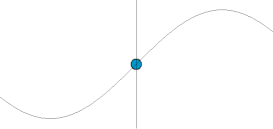In classical mechanics, a harmonic oscillator is a system that, when displaced from its equilibrium position, experiences a restoring force F proportional to the displacement x:
where k is a positive constant.
If F is the only force acting on the system, the system is called a simple harmonic oscillator, and it undergoes simple harmonic motion: sinusoidal oscillations about the equilibrium point, with a constant amplitude and a constant frequency (which does not depend on the amplitude).
If a frictional force (damping) proportional to the velocity is also present, the harmonic oscillator is described as a damped oscillator. Depending on the friction coefficient, the system can:
- Oscillate with a frequency lower than in the undamped case, and an amplitude decreasing with time (underdamped oscillator).
- Decay to the equilibrium position, without oscillations (overdamped oscillator).
The boundary solution between an underdamped oscillator and an overdamped oscillator occurs at a particular value of the friction coefficient and is called critically damped.
If an external time-dependent force is present, the harmonic oscillator is described as a driven oscillator.
Mechanical examples include pendulums (with small angles of displacement), masses connected to springs, and acoustical systems. Other analogous systems include electrical harmonic oscillators such as RLC circuits. The harmonic oscillator model is very important in physics, because any mass subject to a force in stable equilibrium acts as a harmonic oscillator for small vibrations. Harmonic oscillators occur widely in nature and are exploited in many manmade devices, such as clocks and radio circuits. They are the source of virtually all sinusoidal vibrations and waves.
Simple harmonic oscillator[edit]
A simple harmonic oscillator is an oscillator that is neither driven nor damped. It consists of a mass m, which experiences a single force F, which pulls the mass in the direction of the point x = 0 and depends only on the mass's position x and a constant k. Balance of forces (Newton's second law) for the system is
Solving this differential equation, we find that the motion is described by the function
where
The motion is periodic, repeating itself in a sinusoidal fashion with constant amplitude A. In addition to its amplitude, the motion of a simple harmonic oscillator is characterized by its period T, the time for a single oscillation or its frequency f = 1/T, the number of cycles per unit time. The position at a given time t also depends on the phase φ, which determines the starting point on the sine wave. The period and frequency are determined by the size of the mass m and the force constant k, while the amplitude and phase are determined by the starting position and velocity.
The velocity and acceleration of a simple harmonic oscillator oscillate with the same frequency as the position, but with shifted phases. The velocity is maximal for zero displacement, while the acceleration is in the direction opposite to the displacement.
The potential energy stored in a simple harmonic oscillator at position x is
To continue reading click on the link below:
https://en.wikipedia.org/wiki/Harmonic_oscillator
Other references:
https://nanohub.org/resources/4879/download/harmonic_oscillator.pdf
https://chem.libretexts.org/Under_Construction/Users/Gert/Book%3A_A_Companion_to_%22Principles_of_Nonlinear_Optical_Spectroscopy%22_(van_der_Zwan)/0%3A_Primer/0.1%3A_The_Classical_Harmonic_Oscillator








Aucun commentaire:
Enregistrer un commentaire